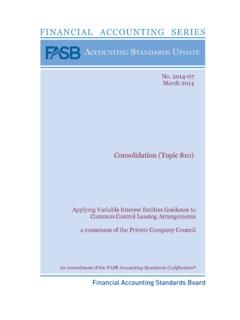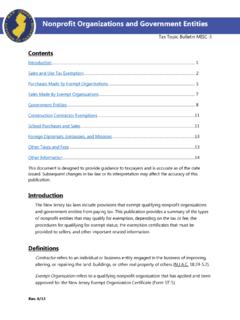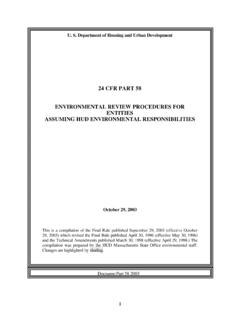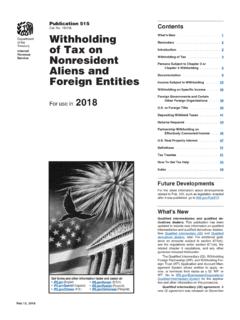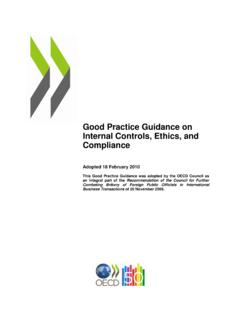Transcription of Tax Exempt and Government Entities EXEMPT ... - …
1 ITax EXEMPT and Government EntitiesEXEMPT ORGANIZATIONS501(c)(3)Compliance Guide for 501(c)(3) private Foundations,,,,Inside:Types of private foundations,,Activities that may jeopardize a foundation s EXEMPT status,,,Federal information and tax returns that must be filed,,,Recordkeeping why, what, when,,,Changes to be reported to the IRS,,,Required public disclosures,,,Resources for private foundations,,,1 Contents,What Is a private Foundation? ..4,What Are the Different Types of private Foundations? ..4,What Activities May Jeopardize a private Foundation s Tax- EXEMPT Status? ..5, private Benefit and Inurement, ..5,Special Restrictions on private Foundation Activities, ..6,Political Campaign Intervention, ..6,Substantial Legislative Activities, ..7,Failure to File, ..8,What Federal Information and Tax Returns Must Be Filed? ..8,Form 990-PF, Return of private Foundation, ..8,Form 990-T, EXEMPT Organization Business Income Tax Return.
2 10,Patient Protection and Affordable Care Act (PPACA) Health Care Tax Credit, ..11,Form 4720, Return of Certain Excise Taxes Under Chapters 41 and 42 of the Code, ..11,Employment Tax Returns, ..12,Why Keep Records? ..13,Evaluate Charitable Programs, ..13,Monitor Budgetary Results, ..13,Prepare Financial Statements, ..13,Prepare Annual Information Returns and Tax Returns, ..13,Identify Sources of Receipts, ..14,Substantiate Revenues, Expenses and Deductions for Unrelated Business Income Tax (UBIT) Purposes, ..14,Comply with Grant-Making Procedures, ..14,2 Contents (cont d),What Records Should be Kept? ..15,Accounting Periods and Methods, ..15,Supporting Documents, ..17,How Long Should Records Be Kept? ..17,Record Retention Periods, ..17,How Should Changes Be Reported to the IRS? ..18,Reporting Changes on Form 990-PF, ..18,Determination Letter and private Letter Ruling Requests, .. 18,Making Grants to Organizations or Individuals.
3 19,Requesting Advance Approval of Scholarshipor Educational Grant Procedures, ..20,Termination, ..20,What Disclosures Are Required? ..21,Public Inspection of Annual Returns and Exemption Applications, ..21,Sale of Free Government Information, ..23,Charitable Contributions Substantiation and Disclosure, ..23,How Do You Get IRS Assistance and Information, ..25,Specialized Assistance for Tax- EXEMPT Organizations, ..25,Tax Publications for EXEMPT Organizations, ..26,Forms for EXEMPT Organizations, ..26,General IRS Assistance, ..27,3501(c)(3)Compliance Guide for 501(c)(3) private Foundations,Federal tax law provides tax benefits to nonprofit organizations recognized as EXEMPT from federal income tax under section 501(c)(3) of the Internal Revenue Code (Code). The Code requires that tax- EXEMPT organizations must comply with federal tax law to maintain tax- EXEMPT status and to avoid Publication 4221-PF, the IRS addresses activities that could jeopardize a private foundation s tax- EXEMPT status.
4 It identifies general compliance requirements on recordkeeping, reporting, and disclosure for EXEMPT organizations (EOs) that are also private foundations, including private operating foundations and non-operating private foundations. Content includes refer-ences to the statute, Treasury regulations, IRS publications and IRS forms with instructions. Publication 4221-PF is neither comprehensive nor intended to address every learn more about compliance rules and procedures that apply to organizations EXEMPT from federal income tax under section 501(c)(3), see Publication 557, Tax- EXEMPT Status for Your Organization, and the Life Cycle of a private Foundation on Stay abreast of new EO information, also on this Web site, by signing up for the EO Update, a free newsletter for tax- EXEMPT organizations and practitioners who represent them. For further assistance, consult a tax Is a private Foundation? Every organization that qualifies for tax- EXEMPT status under section 501(c)(3) of the Code is further classified as either a public charity or a private foundation.
5 Under section 508, every organization is automatically classified as a private foundation unless it meets one of the exceptions listed in section 509(a). private foundations typically have a single major source of funding (usually gifts from one family or corporation rather than funding from many sources) and most have as their primary activity the making of grants to other charitable organizations and to individuals, rather than the direct operation of charitable Are the Different Types of private Foundations? For tax purposes, it may be necessary to distinguish between the particular types of private foundations: private operating foundations, EXEMPT operating foundations and grant-making (or non-operating) private foundations. Some tax law provisions apply to all types of private foundations, while other rules only apply to particular types of private foundations. The organization s exemption letter will indicate whether the organization has been classified as a private foundation, a private operating foundation or an EXEMPT operating foundation.
6 private operating founda-tions and EXEMPT operating foundations are relatively private operating foundation is a private foundation that devotes most of its resources to the active conduct of its EXEMPT activities as distinguished from the more common grant-making foundation that generally makes grants to other organizations for EXEMPT purposes. A museum that is supported by a limited number of individuals would generally be an example of an operating foundation. A private foundation that makes grants to public charities or individuals in order to carry out its EXEMPT purposes would generally be a private non-operating or grant-making foundation. However, grant-making private foundations may conduct their own programs as most of the restrictions and requirements that apply to private foundations also apply to private operating foundations, there are tax advantages to being classified as a private operating foundation. For example, charitable contributions to a private operating foundation qualify for a higher charitable deduction limit on the donor s tax order to demonstrate that it is a private operating foundation, an organization must meet an assets test, a support test, or an endowment test and demonstrate that it distributes substantially all (85% or more) of the lesser of its adjusted net income or minimum investment return directly for the active conduct of activities that further its EXEMPT purposes.
7 5 Certain private operating foundations, referred to as EXEMPT operating foundations, are EXEMPT from the excise tax on net investment income that applies to other operating and grant-making foundations. This type of operating foundation must have been publicly supported for at least 10 years and have a broadly represen-tative board with limited participation by disqualified persons. This type of private operating foundation is extremely nonexempt charitable trust that has not obtained tax- EXEMPT status under section 501(c)(3) is also treated as a private foundation where its unexpired interests are solely devoted to one or more charitable purposes and it has been allowed to receive tax-deductible, charitable Publication 557, Tax- EXEMPT Status for Your Organization, instructions for Form 990-PF, and the Life Cycle of a private Foundation at to learn about nonexempt charitable trusts under section 4947(a)(1) and the different types of private foundations.
8 What Activities May Jeopardize a private Foundation s Tax- EXEMPT Status?Once a private foundation has completed the application process and has established that it is tax EXEMPT under section 501(c)(3), the organization s officers, directors, trustees and employees have an ongoing responsibility to ensure that the organization maintains its EXEMPT status and meets its ongoing compliance 501(c)(3) private foundation should be aware that if it does not restrict its par-ticipation in certain activities and does not absolutely refrain from others, it risks jeopardizing its tax- EXEMPT status. The following four subsections summarize lim-itations on activities of private Benefit and Inurement,A private foundation is prohibited from allowing more than an insubstantial accrual of private benefits, including non-monetary benefits, to individuals or organizations. The intent is to ensure that a tax- EXEMPT organization serves a public interest, not a private one.
9 If a private benefit is substantial, it could jeopardize the organization s tax- EXEMPT addition, no part of an organization s net earnings may inure to the benefit of a private shareholder or individual. This means that an organization is prohibited from allowing its income or assets to accrue to insiders. An example of prohibited 6inurement would include payment of unreasonable compensation to an insider. An insider is a person such as an officer, director, or a key employee who has a personal or private interest in the activities of the organization. Any amount of inurement may be grounds for loss of tax- EXEMPT addition to loss of the organization s section 501(c)(3) tax- EXEMPT status, activities constituting inurement may result in the imposition of self-dealing excise taxes on individuals benefiting from certain transactions with a private Restrictions on private Foundation Activities,There is an excise tax on the net investment income of most domestic private foundations.
10 In addition, tax law rules impose restrictions and requirements on private foundations through the foundation excise tax provisions. These restrictions and requirements include:n restrictions on self-dealing between private foundations and their disqualified persons (defined as substantial contributors, foundation managers, and certain other related persons);n requirements that foundations annually distribute income for charitable purposes;n limits on foundation holdings in private businesses;n restrictions on investments that might jeopardize the carrying out of EXEMPT purposes; and, n provisions to ensure that expenditures further EXEMPT of these provisions gives rise to excise taxes and penalties against the private foundation or in the case of self-dealing, its disqualified persons. The Code contains provisions that impose two-tier excise taxes on private foundations, foun-dation managers, or other disqualified persons that engage in certain prohibited acts.










